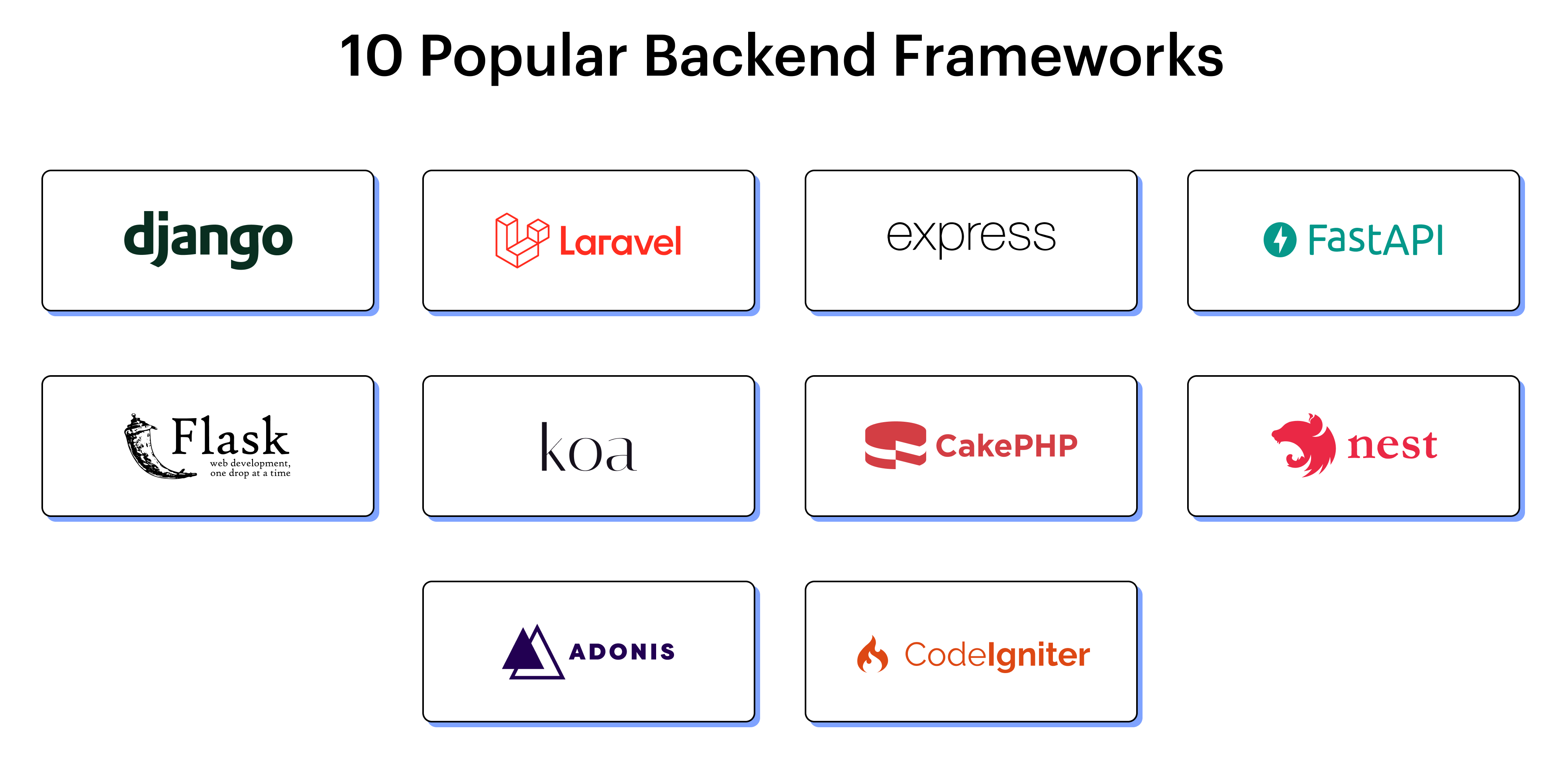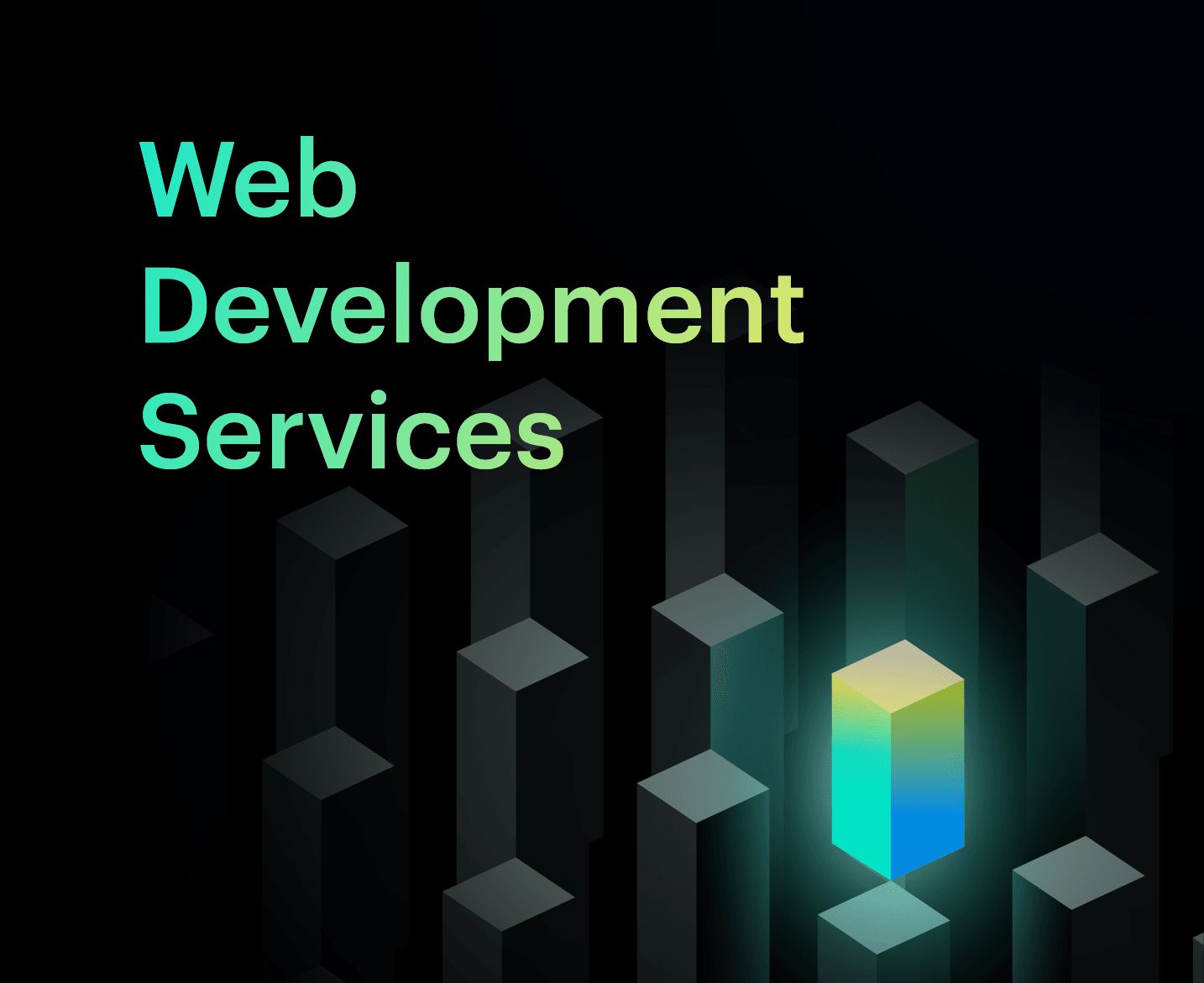10 Popular Backend Frameworks For Web Development In 2025

Have you ever thought about how the website or application you come across offers a high-end user experience with no compromise in its performance? Or how does it retrieve or display the information you require on-demand from the brand simultaneously? The backend framework is the secret sauce behind this flawless experience.
The backend framework is a powerful engine that drives the website and applications, with the potential to handle all the necessary functions and logic to make the project successful. It lays the foundation for developing scalable and robust websites, web and mobile applications. It is responsible for managing server-side operations and databases.
Backend frameworks help software developers build applications more quickly and easily while managing complex tasks such as server configuration, routing, database management, and more.
So, when you wish to build a website or an application for your business, what factors should you consider? Which are the most used backend frameworks you can use in the development modules? Let’s answer these questions in detail in the coming sections of the article.
What is a Backend Framework?
Being a foundation that helps developers make websites, mobile applications, and web applications swifter and more standardised, backend frameworks make development faster and simpler.
Backend frameworks are server-side frameworks built to streamline the developer’s tasks. Backend frameworks encompass a set of tools, libraries, packages, and pre-built components that enable developers to build efficient websites or applications.
Why Use Backend Framework?
The key objective of the framework is to standardise and streamline the development process. You no longer need to write the popular functions from scratch all the time, which accelerates the development.
- Speed: Backend frameworks minimise development time and effort through solutions to perform common operations such as routing, database interactions, and authentication.
- Development Efficiency: With best practices and design patterns and through error-free code, codebase maintenance is simplified.
- Security: Backend frameworks provide in-built security features against potential vulnerabilities, which are important to maintain privacy, integrity and security.
Popular Backend Frameworks
Let’s look at a list of 10 popular backend frameworks for backend web development and app development. While these can cover all your development demands, you need to carefully consider choosing the framework based on the scope of your project, scalability, server costs and many more, which we will discuss in the subsequent sections.

1. Django
Being an open-source Python framework, Django has adopted an MVC (Model View Controller), which segregates the application’s logic, presentation, and data into individual components. Instagram, Spotify, and YouTube have all been built on Django, which is why businesses often rely on skilled Django developers to build scalable and secure applications.
Features of Django
- Object-Relational Mapping (ORM): It offers developers an easy way for database communication to use Python objects instead of SQL queries. ORM controls creating and managing database schema, which makes the interaction between application and database effective.
- Django Admin: This in-built administrative interface arises from Django, which saves the time of the developers in building the admin panel. An intuitive interface lets developers manage the data of an application with a user-friendly dashboard without having to write the code.
- URL Handling: The flexible URL routing system of Django lets developers build human-readable URLs and direct them to the corresponding views. This lets users navigate the application effectively and helps developers frame SEO-friendly URLs.
- Integrated Security Features: Django has integrated security features such as SQL injection protection, password hashing and encryption measures, making it highly secure for backend web development and application development purposes.
- Scalability: Django can manage heavy traffic loads, which makes it ideal for building large-scale applications. It reduces the response time of the application and uses horizontal scaling by deploying web applications on multiple servers.
Advantages | Disadvantages |
|---|---|
| Easy to learn and needs less code to build | The framework deals with how it structures the code, which can limit the developer’s control over the code |
| Developers write code once and reuse it multiple times | Resource utilisation will be higher |
| Includes built-in features like ORM (Object-Relational Mapper), making database management easier | Holds a steep learning curve for beginners |
| A huge and active community that continuously contributes to bug fixes, development, and documentation |
2. Laravel
As a PHP open-source backend framework, Laravel is designed for web application development. It has a modular packaging system with a designated dependency manager. It is considered one of the top backend frameworks and perfect for backend development, according to many experts and top Laravel development companies. Laravel showcases the ability to provide different methods of accessing relational databases and offer utilities to ensure application deployment and maintenance.
Features of Laravel
- Ease of Routing: It offers an easy-to-use routing system that lets developers fix routes for applications with the least effort. Developers can use simple syntax and benefit from the built-in route caching of Laravel to scale the performance of their applications.
- Database Migration System: It provides a powerful database migration system that lets developers manage changes in database schema using PHP. It makes it easy for developers to make schema changes without manual updates.
- Strong Template Engine: With the valuable features of Blade, the Laravel engine, you can create reusable templates and eliminate code duplication in the application.
- Improved ORM: Laravel’s ORM lets developers work with databases with an object-oriented approach. This feature makes it easy to connect with other data sources and implement database operations like creation, reading, updating and deleting records.
- Authentication: Laravel offers an easy-to-use authentication system that makes user registration, user login and logout functionality in the applications easier.
- Security: Laravel includes multiple features that help secure the application like encrypted sessions, secure password hashing, etc. The framework also offers easy-to-use APIs to execute two-factor authentication and password resets.
- Strong Community Support: The vibrant ecosystem of Laravel and vast community support are the inevitable assets for any organisation. It houses an array of third-party packages and libraries that enable developers to use existing solutions while ensuring the quick integration of advanced features, which minimises the cost and development time.
Advantages | Disadvantages |
|---|---|
| Open-source framework | Building large web applications can be tedious and complicated |
| Modular architecture increases the scalability of applications | No built-in authentication mechanisms, so developers might face concerns with security while integrating third-party extensions |
| Built-in command line interface | Developers might face challenges while updating the new versions of this framework |
| Clean and organised code due to MVC architectural pattern | Steep learning curve |
| Includes built-in authentication system that improves security |
3. Express.Js
Express.Js is a Node.js-based lightweight, fast, and flexible framework. It offers a distinctive set of features to build both web and mobile app APIs. It simplifies development by helping developers create dynamic web pages and APIs easily. It has a powerful routing mechanism, large HTTP utility methods and middleware support to manage requests and responses.
Features of Express.Js
- Routing: Express.Js has a strong routing system that lets developers easily map HTTP requests to specific controllers or functions. It makes it easy to build dynamic web applications that respond to user inputs in real time.
- Middleware: Express.Js boasts of its middleware architecture, which lets users add custom functions and plugins to the application pipeline. It lets developers manage requests and responses and add authentication, compression and related functionality to the applications.
- Templating Language: It supports multiple templating languages, including EJS, Pug, and Handlebars. This makes it easy for developers to build dynamic web pages that can be updated in real time without needing to refresh the whole page.
- Error Handling: With Express.Js, developers can access the robust error handling system that lets them catch and handle errors gracefully. This makes it easier to troubleshoot and debug the issues as they occur and ensures a great user experience.
- Scalability: Known for its scalability and performance, Express.Js is a popular choice for building large-scale web applications. The modular architecture lets developers add/remove features as required, and the lightweight design ensures that it can manage high levels of data and traffic without imposing stress on servers or other resources.
Advantages | Disadvantages |
|---|---|
| Great community support and easy-to-find help online | Not designed to build rich user interface |
| Middleware support facilitates ease of integration with third-party libraries | Developers should be adept at Node.js before diving into Express.js |
| Easy way to handle responses and requests to and from the servers with RESTful APIs | Several security issues, like Cross-site scripting and injection attacks, need to be addressed |
| Offers a toolset that enables error handling and debugging, which makes development highly manageable | Lack of in-built ORM means developers should use third-party libraries for database management |
4. FastAPI
FastAPI is a modern, high-performing backend framework that uses Python to build real-time applications, microservices, and APIs using Python that work on standard Python type hints. It lets developers create applications swiftly and efficiently. FastAPI includes features that make building applications easier, like error handling, auto data validation, and interactive API docs.
Features of FastAPI
- Automatic Documentation: According to the type hints and docstrings in the code, it creates automated interactive documentation that uses programs such as ReDoc and UI.
- Type Hinting: Python type hints support ensures that the auto-completion and validation in the latest IDEs are reliable, which enhances the code dependability.
- High-End Performance: Being one of the fastest Python backend frameworks for web development available, it is built for speed. It uses non-concurrent programming to manage various solicitations immediately.
- Easy Validation: Automatic verification of request and input data minimises the likelihood of errors. FastAPI offers a choice of validation techniques to ensure data consistency.
- Authentication & Authorisation: FastAPI supports various protocols like JWT, OAuth 2.0, OpenID Connect, etc., which makes it simple to implement authorisation and authentication.
Advantages | Disadvantages |
|---|---|
| High-end performance due to asynchronous features and high-end request management | User-friendly to beginners and advanced features require more learning |
| Automated generation of documentation that reduces development time and improves API comprehension | The ecosystem keeps developing compared to established frameworks such as Django |
| Syntax and methodology are easily understandable to developers who know Python | There are fewer project templates and conventions compared to most frameworks |
| Type hinting makes code readable and minimises runtime problems |
5. Flask
Flask is a Python-based backend framework that is easy to learn as it has less base code for backend web development. It includes an easy-to-extend core; a microframework that does not have an ORM or related features. Flask doesn’t have a big learning curve, so it is easy to get started with the framework.
Features of Flask
- URL Routing: It offers support for URL routing. This mechanism maps the user’s requests to the specific view functions that render corresponding responses depending on the request method.
- Templating: It comes with Jinja2, a templating engine that ensures an easy separation of business representation and logic. This enables the creation of modular and reusable components.
- HTTP Request Processing: It uses a WSGI toolkit called Werkzeug, for HTTP request handling. It ensures reliable and secure handling of requests, which helps build robust and scalable web applications.
- Web Development: It also offers support for efficient backend web development using tools to test, debug, and profile web applications. They help developers to build more efficient and reliable code.
Advantages | Disadvantages |
|---|---|
| Lightweight and easy-to-use | Micro-framework lacks built-in features found in the full-stack frameworks |
| Offers necessary tools without including specific tools or libraries | User authentication, access control, and user authorisation are not included |
| Swift to set up and use minimal time/resources to build applications | Project structures can vary among the developers, which eliminates uniform standardisation. |
| Highly customisable | Needs additional configuration due its minimalistic nature, which can consume time |
| Ease of access to the comprehensive documentation | Handling large-scale applications can require more effort |
| Third-party extensions can be incorporated without impacting performance |
6. Koa
Koa is a backend framework designed to be expressive and lightweight. It utilises advanced JavaScript features and lets developers write middleware elegantly and concisely. It offers a highly efficient way for HTTP request and response handling, which makes it easy to build scalable web applications, APIs, etc.
Features of Koa
- Flexible Middleware functions: It uses middleware functions to handle requests and responses. Unlike the other web framework that uses a linear sequence, it enables flexibility and versatility. It uses async/await, which facilitates a sophisticated control flow and better error handling.
- Easier Error Handling: Error handling is a key part of any web application, and with Koa, it is easy to manage and propagate errors. During middleware execution, it uses try/catch statements to handle errors effectively against crashing the Node.js server.
- Modular Design & Small Codebase: Koa prioritises flexibility as a minimalist web framework. The small codebase and modular design of Koa make it easy to customise and add novel features to the application. As it is based on the middleware architecture, the functions can be added or removed as required. It makes Koa easy to learn and use for developers who have a good grip on Node.js fundamentals.
Advantages | Disadvantages |
|---|---|
| Lightweight and high performant | Steeper learning curve than many of the other Node.js frameworks |
| Uses a newer Node.js version and offers better support for asynchronous code to handle multiple requests simultaneously | Depends highly on Middleware functions, making the codebase complex and difficult to maintain in the long run |
| Cleaner code than Express.js, easier to read, reuse, and maintain | Doesn’t include ORM support or a built-in database, which means developers don’t need to write code or use external libraries to handle database operations |
| Good error-handling support makes debugging and finding errors in production easy | Relatively small community |
| Built-in response and request object to ease the process of handling HTTP requests and response |
7. CakePHP
A well-known open-source framework written in PHP, it adheres to a Model-View-Controller (MVC) architectural pattern. This separates the data processing, application logic, and presentation layers. Made under the MIT licence, Cake PHP lets developers use it freely to create web applications. It uses prime software design and engineering principles, such as active record, front controller, and convention above configuration.
Features of CakePHP
- Routing: It offers an effective routing system that lets developers define custom URLs for the applications. It makes the application more SEO-friendly and user-friendly.
- Caching: CakePHP provides built-in caching support that can scale the application’s performance. It helps cakephp programmers store frequently accessed data in memory to minimise database queries.
- Templating: It has a built-in templating engine that helps developers define templates for applications. It ensures that the application is highly manageable, simplifies the design process, and facilitates the ease of maintenance.
- Community-Driven Development: As a community-driven development framework, a group of developers maintain it actively. They work continuously to make sure new features and improvements are regularly added.
Advantages | Disadvantages |
|---|---|
| MVC architecture separates the application into three components to ensure ease of scalability and maintenance | The steep learning curve for new developers who are unfamiliar with the system |
| ORM lets developers interact with databases with PHP code to implement a swifter development process | Fewer tools and packages compared to Laravel |
| Features code generation tool that automates Create, Read, Update, and Delete (CRUD) operations for database tables, which saves time | The templating system is less flexible and modern compared to Laravel |
| Built-in tools and plugins to make applications secure, and protect against threats to user privacy and confidentiality |
8. NestJs
Being one of the swiftly evolving Node.js frameworks, NestJs is ideal for building scalable, efficient and enterprise-specific applications. It is popular for producing maintainable, highly testable, and scalable applications that use advanced JavaScript and TypeScript. It uses TypeScript to enable type checking and offers state-of-the-art software architectures to deploy scalable, testable and highly maintainable applications.
Features of NestJs
- Modular Architecture: Modular architecture lets developers organise code into individual modules. Every module holds a specific functionality of the application, thereby helping in code reusability.
- TypeScript Support: Built with TypeScript, NestJS offers powerful typing and advanced language support. It helps catch errors in priority during development and improves code quality.
- Dependency Injection: Based on Angular, its robust dependency injection system makes it simpler to handle and inject dependencies, which improves the testability and scalability of the application.
- Decorator-based Syntax: NestJs defines routes, middleware and related application components using decorators. This makes code easier to understand and more readable. For instance, ‘@Post’, ‘@Get’, and ‘@Controller’ are used to build RESTful endpoints.
- Built-in Support: It provides built-in support for WebSockets, which enables developers to create real-time applications effectively. It also augments the creation of microservices and catalyses the seamless integration of transport layers, which include Redis, TCP, NATS, etc.
Advantages | Disadvantages |
|---|---|
| Robust typescript support and advanced JavaScript features to enhance code quality and maintainability | Steeper learning curve due to unique framework concepts and typescripts |
| Adopts clear separation of reusability, scalability and concerns with a modular structure | Unnecessary complexity for simple and small projects |
| Includes microservices support, powerful dependency injection, and decorator-based syntax to ensure intuitive development | Performance overhead caused by additional abstraction layers |
| Strong documentation and growing community with different plugins and tools | Frequent updates and modifications are due to specific coding structures that evolve rapidly |
9. AdonisJs
As a Node.js web framework, AdonisJs has adopted a Model View Controller (MVC) structure and well-written documentation. With a high emphasis on web security and a growing community, it is evolving into a leading backend framework. AdonisJs, which draws inspiration from Laravel, offers a high degree of flexibility and organisation for your code.
Features of AdonisJs
- Typescript Support: Written in TypeScript, it offers powerful and modern JavaScript features with enhanced development.
- ORM: It provides a powerful ORM known as Lucid, which facilitates seamless database interactions and migrations.
- Authentication: It includes robust authorisation and authentication mechanisms out of the box.
- Powerful CLI: It features a comprehensive CLI (Command Line Interface) tool that supports project migrations and helps you scaffold new AdonisJs projects.
Advantages | Disadvantages |
|---|---|
| TypeScript Integration and modern JavaScript features enhance code quality and maintainability | Steeper learning curve due to the specific conventions, features, and TypeScript |
| Adonis.js adheres to the conventions that trigger development by minimising the requirement for extensive configuration | Smaller community than the other established frameworks, which impact the availability of third-party packages |
| Top built-in features like authentication, ORM, and validation support the development process | A comprehensive set of features introduces performance overhead for simpler applications |
| Robust Command Line Interface (CLI) tools to enhance productivity with the automation of common tasks and project setup. | Adopts a specific method of organising and writing code, which doesn’t align with the preferences of all developers |
10. CodeIgniter
CodeIgniter frames include different outstanding capabilities to offer exceptional performance in a short time. Compared to the other backend frameworks for web development, it offers many ground-breaking capabilities. Based on MVC architecture, it helps to partly separate the view from the backend of the application, which makes the web application more readable and easy to understand.
Features of CodeIgniter
These features make CodeIgniter a preferred choice for many development teams, and many businesses choose to hire CodeIgniter experts to build high-performance applications.
- Lightweight Framework: It is well-known for its lightweight footprint, which makes it highly performing and fast.
- MVC Architecture: It adheres to the MVC architecture (Model View Controller) that promotes an organised code structure.
- User-friendly Documentation: It offers easy-to-understand and extensive documentation, perfect for beginners.
- Built-in Security Features: It provides built-in protection against common threats such as XSS, SQL, and CSRF injection.
Advantages | Disadvantages |
|---|---|
| Simple to setup and use | Limited modern features |
| Lightweight and fast, ideal for applications where performance is the key factor | Small ecosystem and fewer third-party packages than popular frameworks such as Laravel |
| Comprehensive documentation that lets developers learn to implement the framework quickly | Requires more manual configuration for tasks automated in the other frameworks |
| Built-in security features to offer protection against vulnerabilities | Less frequent updates and a slower development pace than most modern frameworks |
| Offers legacy support |
Factors to Consider While Choosing a Backend Framework
We have discussed a wide range of frameworks from which you can choose the one you need to develop a website, web or mobile application. Some of the critical factors you should consider while selecting the backend framework include:
- Speed and Performance
The framework should handle the requests and engage in data processing, which ensures swift response times. Factors like the framework’s architecture, ability to scale to manage the growing user loads, and efficiency of database interactions are important in determining the responsiveness and speed of the application.
- Scalability
A scalable framework lets your application accommodate many users, data and transactions without any compromise in the user experience or performance. Hence, while choosing a backend framework, you need to consider its scalability features like data partitioning, load balancing and distributed computing capabilities.
- Ease of Use
With an intuitive and developer-friendly backend framework, you can streamline the development process, which reduces the learning curve for developers. It offers useful tools and features like security, data management and error handling to ease complex processes.
- Compatibility
The framework should be able to integrate seamlessly with the other tools, backend technologies, and systems you wish to use in the application. The framework should be compatible with front-end technologies, database systems and third-party APIs. Also, understand the framework’s support for different programming languages and platforms that impact the project’s scalability and flexibility.
- Community Support
While choosing a backend framework, you need to consider a robust and thriving community that offers the right support, resources and solutions to the challenges that can occur during development. A strong community helps you with a wealth of knowledge, which makes it easier to find solutions, troubleshoot issues, etc.
Backend Web Development with the Right Framework
Backend frameworks are ideal for developing scalable and feature-rich websites and applications. The world of backend frameworks is wider and more diverse than before. With advanced frameworks and tools, it is important to consider various factors before choosing a compatible backend framework for the application.
WAC offers the best website development services, web and mobile application development services to businesses of all sizes. We can help you choose the most appropriate frameworks and integrate the latest backend technologies to build powerful applications. Our experts backend developers carefully steer the backend development process with careful consideration to ensure high-end ROI and robust functionality.
Talk to our expert today to learn how we have helped large enterprises and fast-evolving startups with the best digital transformation solutions.
If you're looking to strengthen your backend capabilities, WAC also makes it easier to hire JavaScript coders who can support both modern backend workflows and full-stack development needs, helping large enterprises and fast-growing startups achieve seamless digital transformation with the right technology stack.

Expert Web Development Services
Creating solid digital presence and enhancing brand value through web-based products
Discover Digital Transformation
Please feel free to share your thoughts and we can discuss it over a cup of tea.










